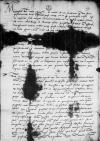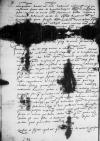Si rarius ad vos scribimus, quam vos forte postularetis, boni consulatis, quaeso, scitis enim, quod principes nostri nisi in negotiis suis magni momenti tabellarios et postas mittere solent, alii vero tabellarii et nuntii istuc profecturi se nobis non offerunt, scripsimus tamen vobis mox post reditum domini ⌊doctoris Borgk⌋ et certo spero, litteras nostras ad vos ad hoc tempus perven stain⌈[hoc tempus perven]hoc tempus perven stain⌉isse.
Sciatis autem, quod regia maiestas propter negotia ducatus Barensis, quae in dies maioribus parantur difficultatibus, vult quod istic adhuc m stain⌈[Sciatis autem, quod ⌊regia maiestas⌋ propter negotia ⌊ducatus Barensis⌋, quae in dies maioribus parantur difficultatibus, vult quod istic adhuc m]Sciatis autem, quod regia maiestas propter negotia ducatus Barensis, quae in dies maioribus parantur difficultatibus, vult quod istic adhuc m stain⌉aneatis, id quod alacri animo facere debetis et certe vobis stain⌈[od alacri animo facere debetis et certe vobis]od alacri animo facere debetis et certe vobis stain⌉ persuadeatis, quod servitus istic vestra est grata maiestati suae stain⌈[est grata maiestati suae]est grata maiestati suae stain⌉, quae vobis per occasionem debita gratia referentur. N stain⌈[ur. N]ur. N stain⌉on timeatis etiam delationes aliquas, quae locum habere contra vos non poterunt, sed curate, ut ea fide et diligentia, qua coepistis, ag stain⌈[ag]ag stain⌉atis res et negotia, quae vobis committuntur et quae putatis dignitati et stain⌈[itati et]itati et stain⌉ utilitati principum nostrorum expedire.
Domine Ioannes, factae stain⌈[factae]factae stain⌉ sunt apud nos hoc anno magnae mutationes, nam dominus ⌊Albertus m stain⌈[lbertus m]lbertus m stain⌉archio⌋, quondam magister generalis Ordinis Sanctae Mariae Teutonico stain⌈[eutonico]eutonico stain⌉rum de ⌊Prussia⌋, ex lupo factus est agnus, ex hoste acerrimo - hum stain⌈[acerrimo - hum]acerrimo - hum stain⌉ilis et obsequentissimus subditus. Mira res dictu, de qua stain⌈[de qua]de qua stain⌉ neque nos neque maiores nostri umquam cogitaverunt. Petiit dari stain⌈[ri]ri stain⌉ sibi in feudum a ⌊maiestate regia⌋, et obtinuit terras illas, civitates et oppida in ⌊Prussia⌋, quae Ordo ipsius possedit ante novissimum bellum, ex quibus iuramentum et homagium debitum hic ⌊Cracoviae⌋ publice et honorificentissime praestitit, ubi excusavit priora errata sua declaravitque, quibus auctoribus et impulsoribus bellum gessit adversus maiestatem regiam avunculum suum promisitque se deinceps omni fide et observantia maiestati suae et regnis ac dominiis suis semper contra quoscumque hostes serviturum et priora errat stain⌈[errat]errat stain⌉a sua suis gratis obsequiis compensaturum. Quia vero haec, quae stain⌈[aec, quae]aec, quae stain⌉ cum ipso facta sunt pro bono pacis communis postulanteque stain⌈[nteque]nteque stain⌉ necessitate reipublicae regni nostri, multi perperam
 BCz, 243, p. 20
interpretantur, dicentes nos sectam Luteranam confirmasse eo, quod permiserimus fratres illos de ⌊Prussia⌋ abicere ordinem et professionem suam ac bona et terras ecclesiae subiectas in potestatem laicam et saecularem dederimus. Mitto tibi epistulam nepotis mei, domini episcopi Premisliensis, quam scripsit domino Antonio Baroni nuntio apostolico in regno Ungariae stain⌈[in ⌊regno Ungariae⌋]in regno Ungariae stain⌉, ex qua intelliges omnes rationes nostras, quibus causam hanc in consilio et delibe stain⌈[causam hanc in consilio et delibe]causam hanc in consilio et delibe stain⌉rationibus nostris perpendimus, et quibus adducti id tandem fecimus, quod necessitas praesentis temporis postulare videbatur, et sciat Vestra Dominatio factum nostrum plane ostendere, nos nihil alienum a profe stain⌈[pendimus, et quibus adducti id tandem fecimus, quod necessitas praesentis temporis postulare videbatur, et sciat Vestra Dominatio factum nostrum plane ostendere, nos nihil alienum a profe]pendimus, et quibus adducti id tandem fecimus, quod necessitas praesentis temporis postulare videbatur, et sciat Vestra Dominatio factum nostrum plane ostendere, nos nihil alienum a profe stain⌉ssione nostra fecisse, sed rebus nostris pacique et quieti stain⌈[e, sed rebus nostris pacique et quieti]e, sed rebus nostris pacique et quieti stain⌉, prout alii quoque homines faciunt, consuluisse stain⌈[e]e stain⌉.
BCz, 243, p. 20
interpretantur, dicentes nos sectam Luteranam confirmasse eo, quod permiserimus fratres illos de ⌊Prussia⌋ abicere ordinem et professionem suam ac bona et terras ecclesiae subiectas in potestatem laicam et saecularem dederimus. Mitto tibi epistulam nepotis mei, domini episcopi Premisliensis, quam scripsit domino Antonio Baroni nuntio apostolico in regno Ungariae stain⌈[in ⌊regno Ungariae⌋]in regno Ungariae stain⌉, ex qua intelliges omnes rationes nostras, quibus causam hanc in consilio et delibe stain⌈[causam hanc in consilio et delibe]causam hanc in consilio et delibe stain⌉rationibus nostris perpendimus, et quibus adducti id tandem fecimus, quod necessitas praesentis temporis postulare videbatur, et sciat Vestra Dominatio factum nostrum plane ostendere, nos nihil alienum a profe stain⌈[pendimus, et quibus adducti id tandem fecimus, quod necessitas praesentis temporis postulare videbatur, et sciat Vestra Dominatio factum nostrum plane ostendere, nos nihil alienum a profe]pendimus, et quibus adducti id tandem fecimus, quod necessitas praesentis temporis postulare videbatur, et sciat Vestra Dominatio factum nostrum plane ostendere, nos nihil alienum a profe stain⌉ssione nostra fecisse, sed rebus nostris pacique et quieti stain⌈[e, sed rebus nostris pacique et quieti]e, sed rebus nostris pacique et quieti stain⌉, prout alii quoque homines faciunt, consuluisse stain⌈[e]e stain⌉.
Facta est et alia hic quoque mutatio in ordine nostro ecclesiastico, mortuus namque est die undecima mensis Aprilis pater et benefactor meus, reverendissimus olim dominus episcopus Cracoviensis, per cuius obitum vacavit episcopatus Posnaniensis, qui mihi ad vitam illius fuit reservatus per Sedem Apostolicam et maiestatem regiam. Credebam ego me illum pro nepote meo, domino Premislie stain⌈[mislie]mislie stain⌉nsi, impetrare potuisse fecique in hoc omnem operam et diligentia stain⌈[ligentia]ligentia stain⌉m meam, verum spes mea me longe fefellit. Enimvero serenissima stain⌈[vero serenissima]vero serenissima stain⌉ obtenta sibi me inscio expectatione de conferendo primo episco stain⌈[primo episco]primo episco stain⌉patu, quicumque vacaret, factaque promissione de illo domino stain⌈[omino]omino stain⌉ ⌊Ioanni Lathalski⌋, nullo modo dimoveri potuit a proposito s stain⌈[posito s]posito s stain⌉uo maluitque servare promissa sua, quam permittere, ut episcopatum illum Posnaniensem nepos meus obtineret, qui, quantum praestet ingenio, doctrina et virtute eidem domino Lathalski, qui iam est declaratus episcopus Posnaniensis, aliorum sit iudicium. Ego in hac petitione mea honesta gravem repulsam magnumque vulnus accepi, quod tamen fero et feram eo animo, quo debeo. Doleo tamen, quod tam parva ratio habita est meae fidei et diuturnae servitutis.
cf. Verg. Ecl. 1. 73 insere nunc, Meliboee, piros, pone ordine vites ⌊Insere nunc, Meliboee, piros pone ordine vitescf. Verg. Ecl. 1. 73 insere nunc, Meliboee, piros, pone ordine vites ⌋ etc.
Questus es saepius apud me per litteras tuas de mala tui provisione.  BCz, 243, p. 21 Ego tibi dixi, cum hinc discederes, ut, cum pecunia deficeret tibi, acciperes illam in mutuum istic a trapesitis ⌊Fucaris⌋ aut aliis quibuscumque, quod ipsum nunc quoque dico et suadeo. Verum est, quod ⌊reginalis maiestas⌋ dicit se ordinasse ex ⌊Neapoli⌋, quod habiturus sis illinc provisionem septuaginta aureorum pro quolibet mense. Ubi tamen illa tempori tibi non solveretur, accipias apud ⌊Fucaros⌋ aut alios trapesitas stain⌈[sitas]sitas stain⌉, quantum necessitas tua postulabit. Ego vero efficiam, quod maiestas regia id solvi faciet, prout et trecentos illos aureos, quos istic recepisti et cirographum tuum dedisti, solvi demandavit. stain⌈[fficiam, quod ⌊maiestas regia⌋ id solvi faciet, prout et trecentos illos aureos, quos istic recepisti et cirographum tuum dedisti, solvi demandavit.]fficiam, quod maiestas regia id solvi faciet, prout et trecentos illos aureos, quos istic recepisti et cirographum tuum dedisti, solvi demandavit. stain⌉
BCz, 243, p. 21 Ego tibi dixi, cum hinc discederes, ut, cum pecunia deficeret tibi, acciperes illam in mutuum istic a trapesitis ⌊Fucaris⌋ aut aliis quibuscumque, quod ipsum nunc quoque dico et suadeo. Verum est, quod ⌊reginalis maiestas⌋ dicit se ordinasse ex ⌊Neapoli⌋, quod habiturus sis illinc provisionem septuaginta aureorum pro quolibet mense. Ubi tamen illa tempori tibi non solveretur, accipias apud ⌊Fucaros⌋ aut alios trapesitas stain⌈[sitas]sitas stain⌉, quantum necessitas tua postulabit. Ego vero efficiam, quod maiestas regia id solvi faciet, prout et trecentos illos aureos, quos istic recepisti et cirographum tuum dedisti, solvi demandavit. stain⌈[fficiam, quod ⌊maiestas regia⌋ id solvi faciet, prout et trecentos illos aureos, quos istic recepisti et cirographum tuum dedisti, solvi demandavit.]fficiam, quod maiestas regia id solvi faciet, prout et trecentos illos aureos, quos istic recepisti et cirographum tuum dedisti, solvi demandavit. stain⌉
Ora stain⌈[Ora]Ora stain⌉tor caesaris, de quo scripsisti, nondum hic appulit nec scimus de stain⌈[de quo scripsisti, nondum hic appulit nec scimus de]de quo scripsisti, nondum hic appulit nec scimus de stain⌉ eo quicquam. Mortuus etiam est illustris dominus dux Fridericus Saxoniae atque stain⌈[t illustris dominus dux Fridericus Saxoniae atque]t illustris dominus dux Fridericus Saxoniae atque stain⌉ ita nescio, quomodo practica, quae de connubio re stain⌈[nubio re]nubio re stain⌉ginulae nostrae istic habita es stain⌈[habita es]habita es stain⌉t, procedere nunc poterit.
Valde bene stain⌈[Valde bene]Valde bene stain⌉ facitis, quod maiestatem regiam redditis(?) copiosi stain⌈[iosi]iosi stain⌉ssime de rebus omnibus certiorem stain⌈[certiorem]certiorem stain⌉, audit enim libenter maiestas sua tuas stain⌈[tuas]tuas stain⌉ litteras et delectatur audi stain⌈[tur audi]tur audi stain⌉re externa et exotica negotia, et proinde stain⌈[proinde]proinde stain⌉ scribatis semper de rebus om stain⌈[per de rebus om]per de rebus om stain⌉nibus copiosissime maiestati suae et in stain⌈[et in]et in stain⌉ causa Barensi operam et dilige stain⌈[operam et dilige]operam et dilige stain⌉ntiam debitam faciatis, qua cumul stain⌈[umul]umul stain⌉abitis vobis singularem gratia stain⌈[singularem gratia]singularem gratia stain⌉m ⌊utriusque maiestatis⌋, quibus ea ipsa causa est plurimum cordi. U stain⌈[plurimum cordi. U]plurimum cordi. U stain⌉t autem sciatis, quid scriptum sit in praesens ⌊maiestati caesareae⌋,⌊ magnifico domino cance stain⌈[magnifico domino cance]magnifico domino cance stain⌉llario⌋ et aliis officialibus maiestatis suae caesareae, et item, quod scriptum stain⌈[et item, quod scriptum]et item, quod scriptum stain⌉ sit summo pontifici in re Prutenica et induciarum, quas cum stain⌈[induciarum, quas cum]induciarum, quas cum stain⌉ ⌊Thurco⌋ inire volumus, mitto vobis copias omnium litterarum stain⌈[litterarum]litterarum stain⌉.
Vestri ⌊Gdanenses⌋ exauctorato veteri senatu et alio ex vili plebe in eius locum suffecto, spoliatis ecclesiis, expulsis monachis sacrisque omnibus profanatis, perstant contumaciter in erroribus suis Luteranis, suntque nunc plurimum animati hoc novo tumultu rusticano, qui excitatus est in ⌊Germania⌋ et qui, nisi tempori cohibeatur, poterit efficere magnam perturbationem in re Christiana.
Non dubito, quin stain⌈[in]in stain⌉ amici tui scribant tibi de rebus tuis et proventibus Columbanis, simul et de hi stain⌈[hi]hi stain⌉s, quae hic apud nos aguntur, quare ego me illis occupare nolo, hoc tamen scias ⌊reginalem maiestatem⌋ nominasse te ad hanc meam ecclesiam Cracoviensem. Licet autem sint adhuc, ut audio, aliae priores nominationes, p stain⌈[p]p stain⌉oterit tamen aliquando haec, quae tibi concessa est, venire ad effectum, in qua stain⌈[qua]qua stain⌉ non deerit tibi favor et patrocinium meum.
 BCz, 243, p. 22
BCz, 243, p. 22
Negotium I undeciphered⌈[I]I undeciphered⌉[1] habeo in bona memoria et, ubi occasio se praebuerit, non negligam consulere fortunis tuis. Bene valete et me diligite.
 BCz, 243, p. 20
interpretantur, dicentes nos sectam Luteranam confirmasse eo, quod permiserimus fratres illos de
BCz, 243, p. 20
interpretantur, dicentes nos sectam Luteranam confirmasse eo, quod permiserimus fratres illos de  BCz, 243, p. 21 Ego tibi dixi, cum hinc discederes, ut, cum pecunia deficeret tibi, acciperes illam in mutuum istic a trapesitis
BCz, 243, p. 21 Ego tibi dixi, cum hinc discederes, ut, cum pecunia deficeret tibi, acciperes illam in mutuum istic a trapesitis 


